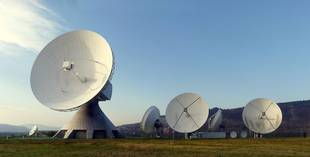
The principle behind radar may sound confusing at first, but a simple experiment can demonstrate the basics. Imagine you are facing the side of a mountain somewhere in the distance. You have a very accurate stopwatch and 'super hearing' to help you.
Now hold the stopwatch in one hand and start timing as you scream as loudly as you can towards the mountain. Stop timing when you hear the first echo of your voice. You have now become a basic radar unit. Since you know how fast sound travels, you can calculate the distance between you and the mountain by using the elapsed time on the stopwatch.
Radar works on many of the same principles demonstrated in this experiment. Instead of one person screaming, a powerful radio beam is sent out at a specific frequency. When this burst of radio energy strikes a solid object, at least part of that sound wave will be reflected back to the transmitter. This signal may not be very loud, but a sensitive electronic receiver can amplify the sound, much like your 'super hearing'. The transmitter and receiver on a basic radar unit are usually mounted close together, much like your mouth and ears.
By calculating the speed of the radio waves and the time it takes for the signal to bounce off the object and hit the receiver, a radar operator can gauge the distance between himself and the object. Moving the transmitter to different points allows the radar operator to receive multiple returns. All of these individual reflections are combined to estimate the size of the object or objects being struck.
Radar technology has improved considerably since the days of World War II, but the underlying principles are still the same. Calculations about an object's speed and direction are made from the results of transmitter and receiver data. When a radar antenna is seen spinning in place, it is sending out thousands of signals and receiving them just as quickly.
Today's radar are computer-aided. The radio frequencies on modern radar systems are also now largely in the microwave range, unlike the shortwave radio frequencies to confuse the receivers looking for authentic ones. Microwave frequencies are much more difficult to jam.


















